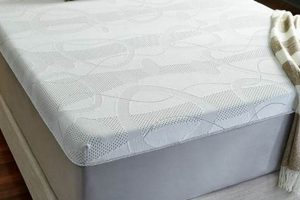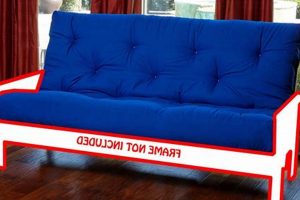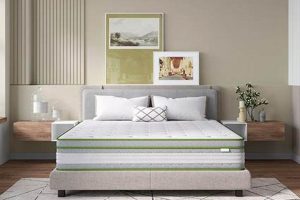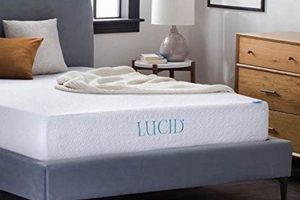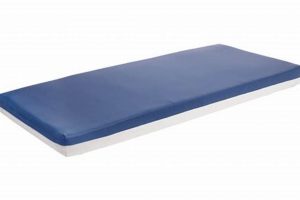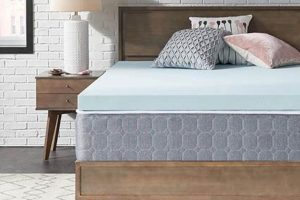These sleeping surfaces offer alternatives to viscoelastic polyurethane foam, often characterized by a distinct feel and construction. Examples include innerspring, latex, and hybrid models that utilize various materials in their comfort and support layers, omitting the specific foam type.
The value of these choices lies in their potential for enhanced breathability, responsiveness, and durability. Historically, innerspring designs dominated the market before the rise of viscoelastic foam; however, current options provide diverse material compositions offering varied comfort levels and support capabilities.
The following sections will delve into the construction, materials, and suitability of different models that forgo the utilization of this specific foam, enabling informed decision-making for prospective purchasers.
Selecting a suitable sleeping surface requires careful consideration of individual needs and preferences. The following points outline key factors when considering models that do not utilize viscoelastic polyurethane.
Tip 1: Prioritize Support. A firm foundation is crucial for proper spinal alignment. Innerspring models should feature a robust coil system, while latex options offer consistent support across the surface.
Tip 2: Evaluate Breathability. Materials such as natural latex and open-coil innerspring constructions promote airflow, minimizing heat retention during sleep. Assess the materials’ inherent properties related to temperature regulation.
Tip 3: Consider Material Durability. Latex is known for its longevity, while innerspring durability depends on coil gauge and construction. Research the expected lifespan of the chosen components.
Tip 4: Assess Motion Isolation. While lacking the specific motion dampening of viscoelastic foam, pocketed coil innerspring systems and dense latex layers can minimize movement transfer between sleeping partners.
Tip 5: Determine Firmness Preference. These sleeping solutions are available in a range of firmness levels, from plush to extra firm. Trialing various models is recommended to identify the optimal comfort level.
Tip 6: Analyze Material Composition. Beyond the absence of viscoelastic foam, understanding the complete material composition is essential. Certifications like Oeko-Tex can indicate adherence to specific environmental and safety standards.
Tip 7: Inquire About Trial Periods. Many manufacturers offer in-home trial periods, allowing ample time to evaluate the product’s suitability before committing to the purchase.
Selecting a suitable sleeping surface involves a thorough assessment of support, breathability, durability, motion isolation, and firmness preferences. Considering these factors will assist in making an informed decision.
The subsequent sections will explore specific materials and constructions in greater detail, providing further guidance in the selection process.
1. Innerspring Support
Innerspring support forms a foundational element in many sleep surfaces that do not utilize viscoelastic polyurethane foam. It represents a traditional yet evolving method of providing core structural integrity and responsiveness. The coil system’s design and material composition directly influence the feel and performance of the sleeping surface.
- Coil Type and Configuration
The arrangement and type of coils significantly impact support characteristics. Bonnell coils, known for their hourglass shape, offer a more uniform support feel. Pocketed coils, individually wrapped, reduce motion transfer and provide targeted support. The gauge (thickness) of the coil wire dictates firmness, with lower gauges indicating firmer support. The configuration, such as zoning (varying coil density in different areas), can tailor support to specific regions of the body.
- Edge Support Systems
Reinforced edges prevent sagging and increase the usable sleep surface area. Edge support can be achieved through the use of thicker coils along the perimeter, foam encasement, or a combination of both. Adequate edge support enhances stability and makes getting in and out of bed easier.
- Material Composition and Durability
The steel used in innerspring systems affects their longevity and resistance to deformation. Heat tempering can improve the coils’ ability to withstand repeated compression. The quality of the upholstery layers above the coil system also contributes to overall durability by protecting the coils from direct pressure.
- Firmness and Responsiveness
The firmness and responsiveness of the innerspring unit contribute to the feel of the sleep surface. A firmer coil system offers greater resistance to compression, while a more responsive system quickly returns to its original shape after pressure is removed. These factors can be adjusted by altering the coil gauge, configuration, and layering materials above the springs.
The design and implementation of innerspring support directly influences the overall performance of models that exclude viscoelastic polyurethane foam. The choice of coil type, edge support mechanisms, and material composition contribute to a surface’s durability, firmness, and ability to provide adequate spinal alignment, thereby influencing sleep quality.
2. Latex Resilience
Latex resilience represents a key attribute in sleep surfaces that do not incorporate viscoelastic polyurethane. Its capacity to recover its original shape after compression is central to both comfort and long-term performance. The inherent properties of this material directly impact the sleeping experience.
- Instant Responsiveness
Latex exhibits immediate reaction to pressure, offering support without the slow conforming characteristic of viscoelastic foam. This rapid recovery allows for easier movement and prevents the feeling of being “stuck” in the surface, a significant consideration for restless sleepers. Examples include shifting positions during sleep without encountering resistance, allowing for uninterrupted rest.
- Consistent Support
The material’s ability to rebound evenly distributes weight and maintains spinal alignment, minimizing pressure points. This constant support contributes to reduced back pain and improved sleep quality. This contrasts with materials that may compress unevenly, leading to discomfort over time. The implication is a sleeping surface that maintains its support characteristics throughout the night.
- Durability and Longevity
Latex’s natural elasticity contributes to its resistance to sagging and deformation. Its resilience means it retains its shape and support properties for extende
d periods, translating to a longer lifespan compared to less resilient materials. Examples include observed performance in long-term use tests, demonstrating minimal compression or loss of support over years of use. - Breathability Enhancement
The open-cell structure of latex promotes airflow, reducing heat retention. This natural breathability complements its resilience, creating a cooler and more comfortable sleep environment. Examples include studies comparing temperature regulation in latex with other materials, showing a significant advantage in minimizing heat buildup.
The interplay between latex resilience and these factors directly contributes to the overall value proposition of sleeping surfaces excluding viscoelastic polyurethane foam. The combination of responsiveness, support, durability, and breathability defines a distinct sleeping experience characterized by comfort and longevity.
3. Hybrid construction
Hybrid construction represents a design approach prevalent in sleep surfaces seeking to balance the benefits of diverse materials while excluding viscoelastic polyurethane. This methodology combines disparate components to achieve specific performance characteristics, offering an alternative to single-material or exclusively foam-based designs.
- Innerspring Core Integration
A core innerspring system provides foundational support and responsiveness. This integration leverages the coil system’s inherent durability and airflow capabilities, offering a more resilient and cooler base layer compared to solid foam cores. For example, pocketed coil systems allow for independent compression, contouring to the body while minimizing motion transfer between sleeping partners. The implications include enhanced support and improved breathability within the overall design.
- Latex Comfort Layers
Natural or synthetic latex layers introduce contouring and pressure relief without the slow-conforming nature of viscoelastic materials. Latex offers a buoyant feel, promoting ease of movement and preventing the sensation of being trapped within the surface. Consider a hybrid model that uses a latex comfort layer combined with an innerspring base for a balance of support and responsiveness. The result is a sleep surface that delivers pressure relief while maintaining overall support and facilitating easy position changes.
- Natural Fiber Components
Materials such as cotton, wool, and silk serve as transition and comfort layers, contributing to moisture wicking and temperature regulation. These natural fibers enhance breathability and create a more comfortable sleep environment by managing humidity and reducing heat buildup. For instance, a wool layer beneath the cover can act as a natural fire retardant and improve airflow, enhancing the overall comfort and safety of the sleep surface.
- Zoned Support Systems
Hybrid constructions may incorporate zoned support systems, employing varying firmness levels in different areas to target specific regions of the body. This strategic approach optimizes spinal alignment and reduces pressure points in areas like the shoulders and hips. An example is a model featuring firmer coils in the lumbar region to provide enhanced support for the lower back, promoting proper spinal alignment and reducing discomfort.
Hybrid constructions offer a diverse range of possibilities for creating sleep surfaces that exclude viscoelastic polyurethane foam. By combining innerspring cores, latex comfort layers, natural fiber components, and zoned support systems, these designs strive to deliver a balanced combination of support, pressure relief, breathability, and durability, providing alternative options for consumers seeking specialized sleeping experiences.
4. Breathability factors
Breathability represents a crucial consideration in sleep surfaces that exclude viscoelastic polyurethane foam. The capacity for airflow and moisture dissipation directly impacts thermal regulation and overall comfort, affecting sleep quality. Understanding the components contributing to breathability facilitates informed product selection.
- Material Composition
The inherent properties of materials influence airflow. Natural latex, with its open-cell structure, promotes greater breathability compared to closed-cell synthetic foams. Similarly, natural fibers such as cotton and wool wick away moisture, enhancing thermal regulation. The selection of materials with inherent breathability characteristics is paramount in models designed without viscoelastic polyurethane. An example includes comparing a latex mattress against a synthetic foam alternative, noting the latex version’s enhanced airflow and reduced heat retention. The implication is a more comfortable sleep environment due to reduced heat buildup.
- Construction Techniques
The arrangement of materials within the sleep surface can either promote or inhibit airflow. Open-coil innerspring systems allow for greater ventilation compared to densely packed foam cores. Similarly, quilted covers with breathable fabrics enhance air circulation. The structural design directly affects heat dissipation. Consider an innerspring model with strategically placed ventilation channels within the comfort layers; this construction enhances airflow and minimizes heat retention. The implications involve improved thermal regulation and reduced instances of overheating during sleep.
- Cover Fabric Characteristics
The outer fabric of the sleep surface plays a vital role in moisture management. Breathable fabrics such as organic cotton, bamboo, or Tencel facilitate the evaporation of perspiration, contributing to a drier and more comfortable sleep environment. Dense, synthetic covers can impede airflow and trap heat. Evaluating the cover’s material composition and weave pattern is crucial when considering models excluding viscoelastic polyurethane. For instance, a cover made from tightly woven polyester will inhibit airflow compared to a loosely woven organic cotton alternative. The implication is that the fabric choice significantly impacts the overall thermal performance of the sleeping surface.
- Airflow Channels and Ventilation
Some manufacturers incorporate specific design features to enhance ventilation within the mattress. This can include strategically placed airflow channels within the comfort layers or specialized edge support systems that promote air circulation. These features actively work to dissipate heat and moisture, contributing to a cooler sleep experience. Models that incorporate ventilation channels within the foam or innerspring layers promote airflow and reduce heat buildup. The benefit is improved thermal regulation and enhanced comfort throughout the night.
The interplay of material composition, construction techniques, cover fabric characteristics, and active ventilation strategies defines the breathability of sleep surfaces that forego viscoelastic polyurethane foam. Recognizing these factors enables a more informed evaluation of potential purchases, leading to improved sleep comfort through enhanced thermal regulation.
5. Pressure relief
Achieving effective pressure relief on a sleep surface that excludes viscoelastic polyurethane foam necessitates careful consideration of alternative materials and construction techniques. This factor remains paramount in ensuring comfort and promoting restorative sleep, regardless of the absence of this specific foam type.
- Zoned Support Systems
Zoned support strategically varies firmness across different areas of the sleeping surface to accommodate varying body weights and pressure points. For example, firmer support under the lumbar region can promote spinal alignment, while softer support in the shoulder area can reduce pressure and discomfort. The targeted approach addresses the specific needs of different body zones, distributing weight evenly and minimizing localized pressure. The implication for mattresses without viscoelastic foam is that pressure relief can be effectively managed through strategic support zoning, ensuring a comfortable and supportive sleeping experience.
- Latex Layering and Density
The density and layering of latex materials can significantly impact pressure relief capabilities. Softer latex layers conform to the body’s contours, cushioning pressure points, while denser layers provide underlying support. The combination of varying latex densities optimizes both comfort and support, mimicking the pressure-relieving properties of viscoelastic foam. A mattress utilizing a softer latex comfort layer over a denser latex support core effectively distributes weight and reduces pressure concentrations. The consequence is a sleep surface that offers pressure relief without relying on the slow-conforming characteristics of viscoelastic polyurethane.
- Microcoil Technology
The incorporation of microcoils within the comfort layers adds a responsive and conforming element to the sleep surface. These small, individually wrapped coils adapt to the body’s shape, providing targeted pressure relief. Microcoils offer enhanced contouring compared to traditional innerspring systems, closely mimicking the pressure-relieving capabilities of foam. A mattress that incorporates a layer of microcoils beneath the cover provides a plush and conforming feel, effectively reducing pressure on sensitive areas. The result is enhanced pressure relief without the use of viscoelastic materials.
- Material Conformability
The ability of materials to conform to the body’s shape without excessive compression is crucial for pressure relief. Materials like natural latex exhibit a high degree of conformability, distributing weight evenly and reducing pressure points. This property allows the sleeping surface to adapt to the sleeper’s unique contours, minimizing discomfort. A natural latex mattress contours to the body’s shape, distributing weight evenly and reducing pressure on sensitive areas. The implication is that the conformability of alternative materials can effectively replicate the pressure-relieving benefits traditionally associated with viscoelastic foam.
In conclusion, achieving effective pressure relief in sleep surfaces that exclude viscoelastic polyurethane foam depends on the strategic implementation of zoned support, latex layering, microcoil technology, and material conformability. These alternatives, when thoughtfully combined, offer viable options for consumers seeking pressure-relieving comfort without relying on viscoelastic materials. Effective pressure relief in mattresses can be achieved through alternative design features, providing a comfortable and supportive sleeping experience.
Frequently Asked Questions
The following questions address common inquiries regarding sleeping surfaces that do not incorporate viscoelastic polyurethane foam, providing clarity on their characteristics and suitability.
Question 1: Are alternatives to viscoelastic polyurethane capable of providing adequate support?
Yes. Support is primarily dictated by the core construction of the sleeping surface. Innerspring systems, latex cores, and hybrid designs utilizing alternative foams can all provide sufficient support, irrespective of the presence of viscoelastic polyurethane. The firmness and responsiveness of these core elements are key factors in determining overall support levels.
Question 2: Can sleeping surfaces that exclude this foam type offer sufficient pressure relief?
Pressure relief can be effectively achieved through various alternative means. Zoned support systems, latex comfort layers, and microcoil technology are examples of design features that distribute weight and reduce pressure points without relying on viscoelastic polyurethane. The specific combination of materials and construction techniques determines the effectiveness of pressure relief.
Question 3: Are these mattresses less durable compared to those containing viscoelastic polyurethane?
Durability is contingent upon the quality of materials and construction methods employed. High-quality innerspring systems, natural latex, and robust hybrid designs can exhibit comparable or even superior longevity compared to viscoelastic polyurethane models. The lifespan of a sleeping surface is not solely determined by the presence or absence of this specific foam.
Question 4: Do mattresses without viscoelastic polyurethane retain more heat?
Viscoelastic polyurethane is known to retain heat. Alternatives, such as innerspring systems with open-coil designs and natural latex with open-cell structures, promote airflow and minimize heat retention. The breathability of a sleeping surface is primarily influenced by the materials and construction techniques used.
Question 5: Are these models suitable for individuals with allergies?
Many individuals with sensitivities find alternatives advantageous. Natural latex, organic cotton, and wool are often hypoallergenic and resistant to dust mites. Material composition should be carefully reviewed to identify potential allergens. Certifications such as Oeko-Tex can indicate adherence to specific safety standards.
Question 6: What is the typical price range for sleeping surfaces that exclude viscoelastic polyurethane?
The price range varies considerably depending on the materials used, construction complexity, and brand reputation. Generally, options range from moderately priced innerspring models to premium latex and hybrid designs. Price does not always correlate directly with quality or suitability; individual needs and preferences should guide the selection process.
In summary, selecting a sleeping surface that excludes viscoelastic polyurethane requires careful consideration of support, pressure relief, durability, breathability, and potential allergens. Understanding these factors enables informed decision-making.
The subsequent sections will offer further insights into specific materials and construction details, providing comprehensive guidance for prospective purchasers.
Conclusion
The preceding exploration has illuminated the characteristics and considerations pertinent to the selection of a mattress without memory foam. Alternative materials such as innerspring, latex, and hybrid constructions present viable options, each with distinct properties impacting support, pressure relief, breathability, and durability. Informed decisions require careful assessment of individual needs and a thorough understanding of available alternatives.
The absence of viscoelastic polyurethane does not inherently equate to a compromise in quality or comfort. By prioritizing core support, evaluating material composition, and con
sidering individual preferences, prospective purchasers can identify a mattress without memory foam that aligns with their specific requirements, contributing to improved sleep quality and overall well-being. Continued research and innovation within the bedding industry will likely yield further advancements in these alternatives, expanding the options available to consumers seeking to make informed choices.


